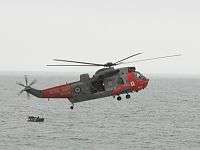Aeronautical Rescue Coordination Centre
| Aeronautical Rescue Coordination Centre ARCC Kinloss | |
|---|---|
|
Royal Navy Sea King | |
| Active | 1997–Present |
| Country |
|
| Branch |
|
| Role | All air-sea rescue and search and rescue in the UK |
| Garrison/HQ |
RAF Kinloss Kinloss, Moray Scotland |
| Nickname(s) | ARRC |
| Motto | Constant Endeavour |
| Aircraft flown | |
| Helicopter | AgustaWestland AW139, AgustaWestland AW189, Sikorsky S-92 |
The United Kingdom's Aeronautical Rescue Coordination Centre (ARCC) is based at RAF Kinloss, near Forres in Moray.
Structure
The centre is responsible for coordinating all Maritime and Coastguard Agency Search and Rescue (SAR) helicopters, and also the Royal Air Force Mountain Rescue Service. It monitors rescues in the United Kingdom Search and Rescue Region (UK SRR), which extends to 30 degrees west in longitude, and from 45 to 61 degrees north latitude (as far north as just south of the Danish Faroe Islands), excluding the Republic of Ireland (Ireland SRR).
Sikorsky S-92 helicopters can operate in excess of 250 miles from their base, with an endurance of over four hours.
AgustaWestland AW189 helicopters can operate in excess of 200 miles from their base, with an endurance of over four hours.
Kinloss has no helicopter squadrons, however it controls rescue helicopters at:
HM Coastguard
- Stornoway Airport on the Isle of Lewis in the Outer Hebrides
- Sumburgh Airport, south of Lerwick in the Shetland Islands
- Lee-on-Solent, four miles west of Portsmouth in Hampshire
- Portland, within Portland Harbour
- Humberside Airport
- Inverness Airport
- Caernarfon Airport
- Lydd Airport
- St Athan
- Prestwick Airport
- Newquay Airport
History
The RAF Search and Rescue Force began in 1941, mainly rescuing aircrew from ditched aircraft. In 1997, the two control centres in Plymouth and Edinburgh were combined into one site at RAF Kinloss.
Preparedness
Coastguard helicopters are on standby 24 hours a day to assist those in difficulty, both at sea and over land. Helicopter crews are at 15 minutes notice during the day, reducing to 45 minutes at night.
Control centre
The control centre is manned by military staff, supplemented by civilian MOD employees who operated the long-range HF communication equipment. Using an IBM-based Rescue Coordination System (RCS), the coordinators task helicopters following requests from the emergency services. With an area of responsibility spanning almost 1 million square miles, the ARCC deals with incidents across the whole of the UK out to half way across the North Atlantic.
Personnel
ARCC coordinating staff come from a variety of backgrounds, including SAR helicopters, RAF Nimrod patrol aircraft, and Mountain Rescue, and work very closely with the Coastguard, Police, Ambulance Authorities and Fire & Rescue Services.
Incidents

During recent years the ARCC has assisted with rescues during the Sheffield floods, the Grayrigg Rail Crash and the Boscastle floods, and deals with over 2000 incidents each year.
UK Mission Control Centre
The ARCC is also home to the UK Cospas-Sarsat Mission Control Centre (UKMCC). This is the centre that detects emergency beacons within the UK Search and Rescue Region (SRR) using an advanced computer system. Maritime distress beacon information is passed to the Coastguard authorities but terrestrial alerts are investigated by the UKMCC, often requiring the use of SAR helicopters to pinpoint the beacon's position.
